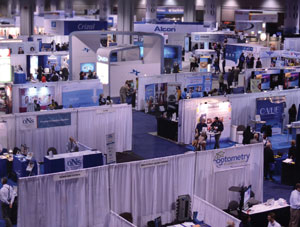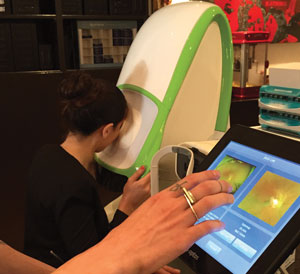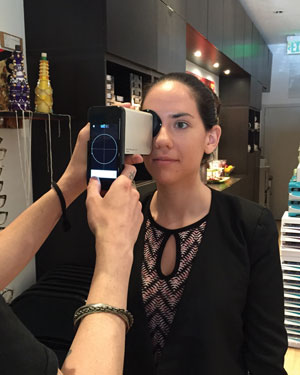Technology can be both a blessing and a curse for your practice: it enables you to provide exceptional patient care, yet the push to obtain the latest and greatest gadgets can put a huge strain on your budget and your patience. If it’s time to invest in new technology or upgrade your current equipment, you might be reeling from your options.
This article walks you through some of the main questions you should ask yourself when considering new equipment, as well as tips for making the shopping and purchasing experience a positive one.
What to Buy
The first step is always to decide what you truly need. While replacing a broken phoropter or slit lamp is a no-brainer, other choices aren’t so obvious. Andrew S. Gurwood, OD, a professor and attending optometric physician at the Eye Institute of the Pennsylvania College of Optometry at Salus University, Philadelphia, breaks the decision down into two categories: need and economy.
 | |
| Conference exhibit halls provide an excellent opportunity to see many technologies in action and get a feel for which ones will fit your practice. |
“Need for a new instrument implies that the new instrument provides data you can’t currently capture and require to practice, or will make practice easier,” Dr. Gurwood says. “Need, with regard to upgrading an instrument you already have, implies that the instrument you want to upgrade is inconsistent, unreliable, is in disrepair or lacking new advancements which permit the user some advantage in practice,” such as software that assists interpretation.
While need is usually easy to determine, economy often is not. It’s a careful balance between what you can afford and the revenue new equipment could generate for the practice, Dr. Gurwood says. He suggests optometrists carefully consider if the cost is outweighed by the time it will save them or the reimbursements it will generate. He gives two examples:
Good purchase: An auto lensometer. “There is no reimbursement, but it eliminates a tedious task that is done on almost every patient, making its value-for-dollar high,” Dr. Gurwood suggests.
Bad purchase: A B-scan. “This is a terrific instrument to have; but, unless you are purchasing it for the tax advantage at an average cost of $27,000 per unit, it makes little sense if your history of need over a five-year period is one time,” he says.
Alan Glazier, OD, founder of Shady Grove Eye and Vision Care in Rockville, Md., and the “ODs on Facebook” page, agrees that practitioners must carefully balance need with economy, especially since not all diagnostic equipment is revenue generating.
“‘Not billable’ doesn’t mean there isn’t a business benefit, as these devices often save time, enabling more exams and add to the technical sophistication—and reputation of—the office, but there is no direct income from them,” Dr. Glazier says. “All of these products need to be paid for, so it is important to understand what financial value they bring to the practice.”
 | |
| Nothing wows patients more than seeing nearly the entire inside of their eye. That reaction means a deeper understanding of what we are doing, and it hopefully translates into a greater desire for routine annual care. Photo: Justin Bazan, OD. |
Of course, specialists will have to budget for the specific instruments they will need to successfully run a specialist practice, Dr. Gurwood says. A retina specialist, for instance, would have greater justification for upgrading from time-domain to spectral-domain OCT than a general optometrist.
Who to Buy From
Choosing the right vendor can make all the difference in your buying and implementation experience. Drs. Glazier and Gurwood agree that reputation for service should be your number one consideration when you are deciding between vendors.
“Machines break—it’s a fact,” Dr. Gurwood says. “What matters is the company’s response to your needs, permitting quick and accurate diagnosis of the problem and a reliable and timely solution that will permit uninterrupted, seamless ongoing business.”
So make sure the vendor you choose has exceptional customer service and helpful policies such as “providing a loaner when the instrument is being repaired or providing additional training for new staffers or if the current staff isn’t achieving results,” Dr. Gurwood recommends.
With technology changing at such a rapid pace, a good working relationship with your vendor is a must. Whether it’s software upgrades, integration concerns, hardware failures or staff training issues, you want to know your vendor will be there to help. And don’t think you are on the path of technological advancement alone. Bill Potter, OD, chief of Optometry and Contact Lens Services at Millennium Eye Care in West Freehold, NJ, says consulting with colleagues who have recently purchased the equipment you are looking to buy can give you exceptionally useful information on their purchasing and implementing experiences. “Online forums like ‘ODs on Facebook’ can make this even easier,” he adds.
7 Tips for Shopping Success
Overall, adding new technology to your office can be satisfying, as long as you take all the right steps to ensure personal and patient satisfaction, along with financial success. |
How To Finance
The biggest hurdle, by far, is managing to finance these upgrades. To ensure you are making the best financial decision—and saving as much as you can in the process—work closely with your practice’s accountant, Dr. Glazier says. A professional can make sure it’s the right time to buy for tax purposes, help you research and compare vendor rates and estimate revenue generation. “You should earn more from the machine per month than you pay in a lease payment, and use conservative numbers in your calculations,” Dr. Glazier advises.
But practitioners have more than one option when financing big purchases, according to Dr. Gurwood. He suggests considering a planned replacement schedule.
 | |
| A smartphone-based autorefractor, such as the SVOne (Smart Vision Labs), eliminates patient anxeity behind a table-top autorefractor. It also helps alleviate pretest bottleneck, often speeding up subjective refraction to mere seconds. Photo: Justin Bazan, OD. |
“Planned replacement recognizes that new and improved models of something will be released every three to five years. ‘Taxing’ one’s practice a small percentage of the reimbursements from a given instrument with the intention of replacing it based on a predetermined schedule permits cost averaging,” Dr. Gurwood explains. Cost averaging spreads the cost of the new device over time, making it far more manageable, he says. “This is a method used by municipalities to replace fire apparatus or the police fleet. Instead of realizing a $400,000 expense in one year, the ‘planned’ replacement time can be placed on the calendar and saved for many years, making it a painless per-day process.”
But buying new equipment isn’t always the best way to go. If you find yourself ogling the latest model OCT—every year—leasing instead of buying is a great option. Just like trading in your car every two or three years for the newest model, leasing allows you to upgrade to the latest and greatest with little hassle.
“You would tend to lease if you are worried about Moore’s Law of technology making the device obsolete in 18 months. If we are worried that the next OCT technology will render our current spectral-domain instrument obsolete, we may do a lease,” Dr. Potter says. However, “we purchased some optical manufacturing equipment, when we were confident that the machine was durable and the technology would not leapfrog.”
Financially, leasing can have just as many pros and cons as buying. “While leasing may have a lower payment,” Dr. Potter says, “instrument values can plunge even faster than those of a car, so the lease rate may not be extremely different from the purchase.”
“It becomes as much an accounting decision as a professional one, as depreciation rates vary, and every practice has different cash flow problems and needs,” he adds. With all of these balls in the air, it’s often best to decide if the need to upgrade warrants a lease, and then decide on a financing option.
When To Buy
If you are in the market for new technology, a conference exhibit hall might be the perfect place for you. “Conference exhibit halls usually are great places to test different equipment, check the look, feel and performance, and make comparisons all at once,” Dr. Glazier says.
While the exhibits give you the chance to “kick the tires,” so to speak, the vendors also often have lectures that demonstrate the benefits and applications of their technology for your practice, Dr. Gurwood says.
However, Dr. Potter cautions that exhibits tend to be unusually polished and produce optimistic presentations, so be sure to speak with the product representatives independently to make sure they have the expertise necessary to foster a positive relationship with you and your staff.
“Interviewing the demonstrating company’s representative can be all-telling. No one has all the answers, but absence of expertise and failure to follow-up on a question can be death knells for the doctor-vendor relationship,” he says. “Simplistically, the device has to be flawless on the exhibit floor. I recently witnessed the total failure of a testing device on an exhibit hall floor. The representatives were floored and without answers.” Needless to say, those who witnessed the presentation disaster steered clear of that vendor for their future purchases.
Make the Most of a Technology Exhibit
|
But if everything goes well and the vendor’s presentation gave you the peace of mind you needed to make an informed decision, “there is usually a conference discount if you purchase at the conference,” Dr. Glazier adds. Vendors have sales quotas to hit, giving you leverage—use it!
How to Train Staff
No matter how or when you upgrade your technology, staff training is going to be an integral part of the process. Staff needs to understand why you are upgrading your equipment and how it will impact patient care, says Jason Miller, OD, a faculty member at Ohio State University and practitioner at Eye Care Professionals of Powell, Ohio.
Getting your staff on board will be key to a smooth integration, he adds. He suggests the emergence of retinal imaging as an example. “It is a great tool to be able to show patients their retinal photos and potential diseases found in the retina,” he explains. “If staff doesn’t understand why they need to recommend this technology during the pre-exam, utilization will not be very high.”
Luckily, this is where your careful vendor selection pays off. While you should make sure your new instrument is easy to use, you should also make sure the vendor takes care of installation, orientation and staff training, Dr. Gurwood says. Even though you probably won’t be the one running the tests most of the time, you still need to be trained on performing them—and of course interpreting the data.
At the end of the day, no matter how high-tech your new equipment, it all boils down to proper staff education. “Utter failure results if staff is poorly trained,” Dr. Potter says.
Why Patients Are the First Concern
While you are juggling financial, space and staff concerns, never lose sight of why you wanted the new technology to begin with: to improve patient care. All upgrades and new purchases should positively impact your patients’ experience in your office—but sometimes that goal can get lost in the minutia of the buying process.
“The newest technology is always great and may provide a ‘wow factor’ with your patients,” Dr. Miller says. “But if it adds more patient or staff time, it may backfire.”
That new OCT may be fantastic, but shuffling patients to and from the only pretesting area you could squeeze it in could quickly create a scheduling and workflow nightmare. You want to offer your patients the best in diagnostic testing, but you don’t want them waiting in line for it.
The bottleneck a single pretesting area creates “is frustrating to patients and staff and can result in less efficiency, less income and cause customer loyalty and service issues,” Dr. Glazier says. He recommends purchasing more diagnostic equipment—when finances allow it—for a second pretesting area to improve your office’s patient flow, thereby increasing efficiency.
New equipment is your chance to improve your office’s workflow, so take note of technology causing bottlenecks and add it to the short list for replacement. Dr. Miller mentions his office’s patient education videos as a prime example.
“The patient educational videos we used to have for floaters, glaucoma, presbyopia and so on were always useful, but were a challenge to integrate into normal patient flow because the programs ran on the same computer as my EHR,” Dr. Miller says. “Many of the new educational video systems now run on a tablet, and now we can input exam data while the patient watches the short video on a tablet, thus making us more efficient in the exam lane.”
Another patient-centric consideration is the data the instrument produces. Are the printouts easy to present to the patient? As an example, Dr. Potter says he can “show you a printout on a patient with a vitreoretinal adhesion, whose description is extremely abstract without a good graphic and a model eye.” Most new equipment will have good printouts, he says, but just make sure this is the case before you take on the hefty payments.
Your new technology should be worth every penny you spend. While many upgrades pay for themselves in reimbursements, the more significant value lies in the technology’s ability to transform how you care for your patients. So go ahead and browse every vendor’s booth at your next conference, and ask questions. Just remember who, what, when, why and how to go about being a smart shopper, and your patients—and practice—will be thrilled with your savvy purchases.
